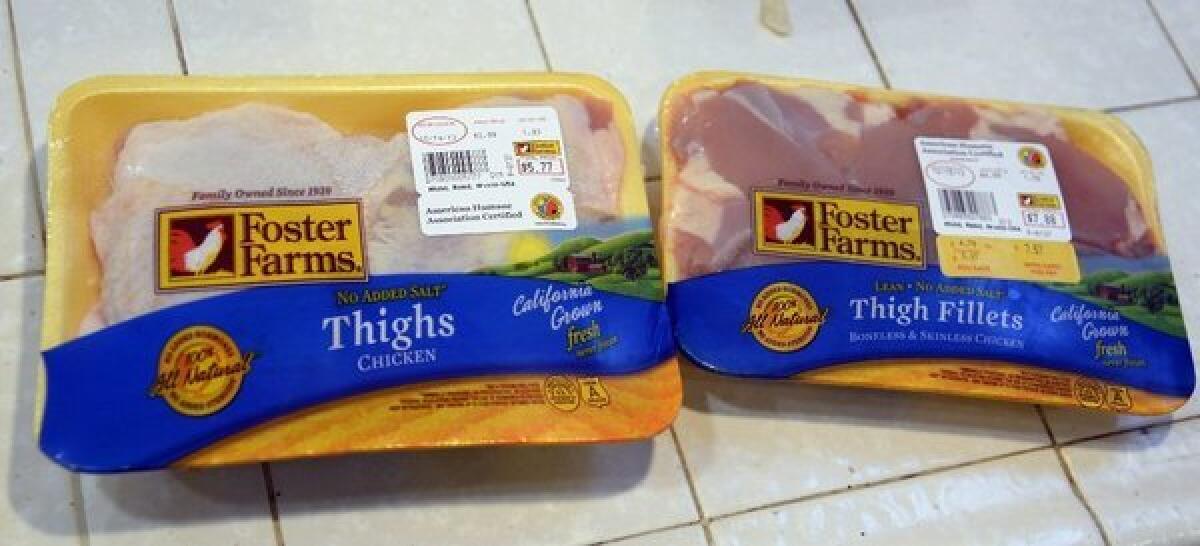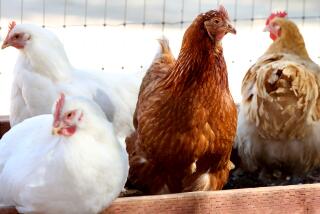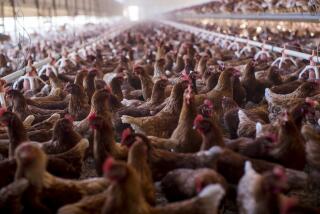Want to fight salmonella? Don’t eat chickens.

- Share via
Everyone knows that squalor -- the kind most of the chickens people eat suffer before being slaughtered -- is a paradise for pathogens like salmonella. Disease microbes thrive in densely populated, dank, sunless places. To minimize the spread of infectious organisms among human and animal populations, sanitation, sunlight and the healing gift of space are necessary.
These necessities are not present in the long, low buildings in which the majority of commercially raised chickens and turkeys sit in excrement while breathing toxic ammonia fumes from the manure that is everywhere in these buildings, from the machinery to the bedding to the birds. The Times’ Oct. 21 editorial proposes the downstream idea of the federal government recalling all salmonella-tainted chickens, a solution that falls short.
ABOUT BLOWBACK: FAQs and submission policy
Virtually all of these birds -- whose immune systems are weakened by the effects of artificial breeding, growth-promoting antibiotics, rough handling, lack of exercise, bad diet and pathogen overload -- go to slaughter with crippled joints, ammonia-burned skin and respiratory infections. A big white breast or sauce-smothered wing does not signify a healthy bird.
As far back as 1987, U.S. Department of Agricultural official William H. Dubbert told a poultry symposium at Colorado State University, “We know more about controlling salmonella than we are willing to implement because of the cost factor.” He meant that you cannot mass-produce cheap poultry products and make a profit without cutting some very big corners. This isn’t just a U.S. issue or one limited to salmonella. As noted in the British trade magazine World Poultry in 2007, “Disease-causing organisms are ubiquitous in poultry-producing facilities all around the world.”
That same year, an article in the trade publication WATT Poultry USA observed, “We all know that pathogens of all forms, such as bacteria, fungi, and viruses, are everywhere in the animal-production environment and will remain, regardless of techniques adopted.”
The modern poultry environment, from hatchery to slaughterhouse, is inherently disease-causing. This environment flouts nature with predictable results. I happen to live in one of the largest poultry-producing areas in the United States -- the Delmarva Peninsula, on the Chesapeake Bay -- where at any given time a half a billion chickens are confined in thousands of contaminated buildings that grossly pollute the bay.
Although Sweden may be minimizing its share of the global spread of salmonella-infected poultry and eggs -- efforts The Times’ editorial lauds -- here in the United States, plans are not underway to reduce the artificial growth rates, crowding, stress, pollution and animal cruelty responsible for making birds sick and putting human handlers and consumers at risk of infection. With or without antibiotic treatment, these microbes don’t necessarily just “go away.”
If fact, the increased use of chemicals in the U.S. to ward off salmonella in poultry plants is doing something the microbes can do by themselves: making people sick.
Earlier this year, the Washington Post reported on the health risks posed by the use of these bacteria-killing chemicals. Focusing on the death of a federal poultry inspector in 2011 -- whose lung collapse was linked to his exposure to these “stopgap” chemicals -- the Post explained how fewer federal inspectors, other government cost-cutting measures and faster line speeds have all conspired to boost the use of toxic chemical sprays and soaks to kill bacteria in chickens. Along with the usual chlorine bath, an even more dangerous chemical, peracetic acid, is now being used to destroy salmonella and other pathogens on infected birds.
And they are not the only chemicals the birds are bathed in, nor do they ensure a pathogen-free outcome.
The Times’ declaration that non-vegetarians shouldn’t have to accept tainted chicken as unavoidable overlooks these gruesome realities; it also ignores that we do not need to eat chickens or any other animals to be healthy. Instead of waiting from here to eternity for the poultry industry and the government to “do something,” we can take matters into our own hands by choosing to eat differently.
ALSO:
Deasy stays at L.A. Unified. Now what?
Karen Davis is the president of United Poultry Concerns, a nonprofit organization that promotes the compassionate and respectful treatment of domestic fowl.
If you would like to write a full-length response to a recent Times article, editorial or Op-Ed and would like to participate in Blowback, here are our FAQs and submission policy.
More to Read
A cure for the common opinion
Get thought-provoking perspectives with our weekly newsletter.
You may occasionally receive promotional content from the Los Angeles Times.










